#Beast facts
Text

learned something about myself lately
#i dont think its even the fact almost all my characters are somewhat beasts in one way or another. i just#really like tails and wish i had one myself#and then my oc designs are a little tame theyre mostly human shaped with animal features. but they always have tails#my eyes have recently been opened to the appeal of long whiplike unicorn tails.. so flowy and curly#something about the tuft at the end being long and swirly just does something for me..#maybe it would make sense to change auggies tail shape so it looks like a meteor. her design is mainly pink with hot pink accent#so it would be cool to use that and orange to make it look like a fire meteor.. maybe itll help complement the blue/green in her design#head full of ocs today so expect a ramble later#if i had a tail i think it would be long with a kink. so it kind of folds over once but not in a curl#when it wags its kind of a swaying motion. i have thought about this a normal amount#yapping
9K notes
·
View notes
Text
listen i do not believe i'm able to communicate with chao in any way but when the unmistakable sound of raccons having a fistfight on the roof broke out and we looked at each other I firmly believe the shared thought was "you hear that too, right?"
#chao the chaos beast#cats#also i inclined my head at the door and said can you go check that out#she gave me a look that i am choosing to anthropomorphize as chagrined and did in fact go check it out#they're in one of the trees now and i can hear them
2K notes
·
View notes
Text

hc i have of twilight: the most intense blue eyes ever
#based on the fact that he's constantly called a 'blue eyed beast' in tp#i had to make this.#tloz#loz#lu#the legend of zelda#legend of zelda#linked universe#wild lu#twilight lu#lu wild#lu twilight#tloz fanart#loz fanart#mosa-art#fanart
2K notes
·
View notes
Text
Wet Beast Wednesday: moray eels
This week on Wet Beast Wednesday I'll be going over something amazing, a fish with a sense of morality. You see, the moral eel is known for, what... I think I'm reading this wrong. Oh, MoRAY eel, not moral. Well this is awkward. Hang tight, I need to go redo my research.

(Image: a green moray (Gymnothorax funebris) swimming outside of its burry, with its whole body visible from the side. It is a long, slender fish that looks a bit like a snake. A long fin starts just below the head and continues down the length of the body. The body is arranged in a wave pattern. It has a pointed snout and small eyes. Its body is a yellow-green color. In the background is the sandy seafloor, dotted with various sponges and corals. End ID)
Moray eels are true eels, meaning they are in the order Anguiliformes. Yeah, I did wolf eels, electric eels, and lamprey eels before I got around to actual eels. There are over 200 known species of moray eel in 15 genera. Like other eels, they are elongated bony fish with extra vertebrae and reduced fins. Moray eels have fewer fins than most eel species, only having a dorsal, anal and tail fin that merge together and run down the back of most of the body and underneath portion of it. They achieve motion by undulating this long fin and sometimes undulating the rest of the body as well. Moray eels aren't the fastest of fish, but they can swim backwards, something almost no fish can. The head has a long snout with wide jaws. Most species have long fangs used to grab onto prey, but a few species are adapted to eat hard-shelled prey and have molar-like teeth to crush through shells instead. Probably the coolest feature of morays are the pharyngeal jaws. This is a second set of jaws located in the back of the mouth. When the eel bites onto prey, the jaws can be shot forward to grab the food and help pull it into the throat. While lots of fish have pharyngeal jaws, morays are the only ones who can extend their pharyngeal jaws forward and use them to grab prey. Morays have smooth, scaleless skin that is often patterned to provide camouflage. The skin is coated in mucus that provides protection from damage and infection. In some species, the mucus can be used to glue sand together to help reinforce burrows. Morays lack lateral lines, a system of organs found in most fish that senses changes in water movement. Their sense of smell is their primary sense. The size of morays varies between species. The smallest species is the dwarf moray eel (Gymnothorax melatremus) which reaches 26 cm (10 in) long. The largest species by mass is the giant moray eel (Gymnothorax javanicus) which can reach 3 meters (10 ft) and 30 kg (66 lbs) while the longest species is the slender giant moray (Strophidon sathete), the longest known specimen of which measured in at 3.94 m (12.9 ft).

New reaction image
(Image: a giant moray (Gymnothorax javanicus) emerging from a burrow. It is brown and mottled with yellowish patches. Its head is pointed at the camera and it's mouth is wide open, aming it look shocked. End ID)

(Image: an anatomical diagram of the skeleton of a moray eel emphasizing the pharyngeal jaws and the muscle attachments. End ID. Art by Zina Deretsky)
Moray eels are found throughout the Atlantic, Pacific, and Indian oceans. Different species are found in different temperatures and depths, though most species live in relatively shallow, warm water. Several species can live in brackish water and a few will swim upriver and live for a time in fresh water, though there do not appear to be any species that live their entire lives in fresh water. Morays are ambush predators who rely on the element of surprise. They live in small, tight places such as holes in coral, gaps between rocks, or sandy burrows. When prey passes, the eel can lunge out and grab it. Unlike most fish, the eel cannot use suction feeding due to the shapes of their mouths. They have to rely on lunging froward and catching prey with their mouths. Their mouths are adapted in shape to push water to the sides. This reduces water resistance and avoids creating a wave that could push prey away from the eel. If an eel catches prey that cannot be swallowed whole, it will tie itself in a knot while biting on to the food. By pulling its head through the loop, the eel can rip the food into bite-sized pieces. Spending most of their times in burrows also provides protection from predators, especially in juveniles or smaller species. At night, the eels will come out of their burrows to hunt sleeping prey while the larger predators are asleep. Giant morays have also been seen engaging in interspecies cooperative hunting with roving coral groupers (Plectropomus pessuliferus). The eels can fit into small crevices the groupers can't to flush prey into the grouper's path while catching their own. Morays are mostly solitary species and many can be territorial. They are known to be shy and will retreat into their burrows if they feel threatened. They are also curious and many species are quite intelligent.
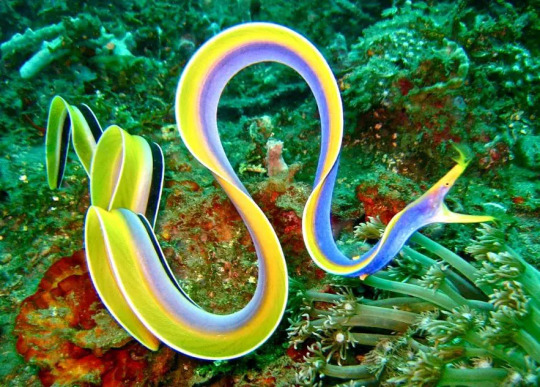
(Image: a male ribbon eel (Rhinomuraena quaesita) on a coral reef. It is a very long and slender eel with its body curved in many waves. It is brightly colored, with a blue-purple body, yellow fin and face, and a long black and white stripe running down the back half of the body. On the nostrils are two feather-like structures. End ID)
Morays reproductive strategies are poorly known and differ based on species. While many species seem to have no set mating season and will reproduce whenever they can, others will mate at the same time every year. Some species seem to have dedicated spots to lay their eggs and a few are believed to be anadromous, meaning they travel from the sea to fresh water to spawn. Meanwhile, some of the species that spend a lot of time in fresh water are catadromous, meaning they return to sea to mate. Females will lay their eggs and the male fertilize them. After this, they depart, providing no parental care. As with all true eels, moray eels begin life as leptocephalus larvae. This type of fish larvae is notable for its resemblance to a simple, transparent leaf with a head on one end. These larvae are unique and poorly understood, despite being the larval stage of a lot of different species of fish. They are unusually well developed for larvae, capable of active swimming and generally living life. In fact, some particularly large leptocephalus larvae were initially mistaken for adult fish. They feed mostly on bits of drifting organic material called marine snow and can remain in the larval stage for up to 3 years, with those in colder conditions usually taking longer to metamorphose. All leptocephalus larvae start out with no sex organs, then develop female organs, then develop male ones, becoming simultaneous hermaphrodites. They will ultimately become eith male or female and it is likely that environmental factors are the main determining factor. During metamorphosis into a juvenile, the leptocephalus can reduce in size by up to 90%, resulting in the juvenile being smaller than the larva. The process of maturation is poorly understood, but it seems that most morays will be sexually mature by three years of age.

(Image: multiple photos of a particularly large leptocephalus larva (not sure what species). It is a translucent organis, wth a body shaped like a very long leaf, narrow at both ends. In the frint is a very tiny head. End ID)
Morays are shy and generally avoid humans. Though some cultures have hunted them for food, they are often not considered a particularly good food source. Many species have high levels of chemicals called ciguatoxins in their bodies, which can lead to a condition called ciguatera fish poisoning if eaten. The largest threat to morays is habitat loss. This is especially true for the many species that live in coral reefs, which are in increasing danger due to global warming. Attacks on humans are rare and usually happen as a response to a human sticking their hand in the eel's burrow. Some of the large species could cause significant damage with a bite. Some species, usually the smaller ones, are found in the aquarium trade, thought they are not good pets for beginners as even the smallest morays are still large for aquarium fish and have some specific requirements. The curiosity many morays have has led to some becoming familiar with and even friendly to humans, often the result of feeding them. They can recognize individual humans and remember them over the course of years. Aquarium employees sometimes report that the eels will come to nuzzle and play with them and have personalities like dogs. Marine biologists and professional SCUBA divers Ron and Valorie Taylor befriended a pair of eels they named Harry and Fang at the Great Barrier Reef who would remember them and come out to visit them year after year.
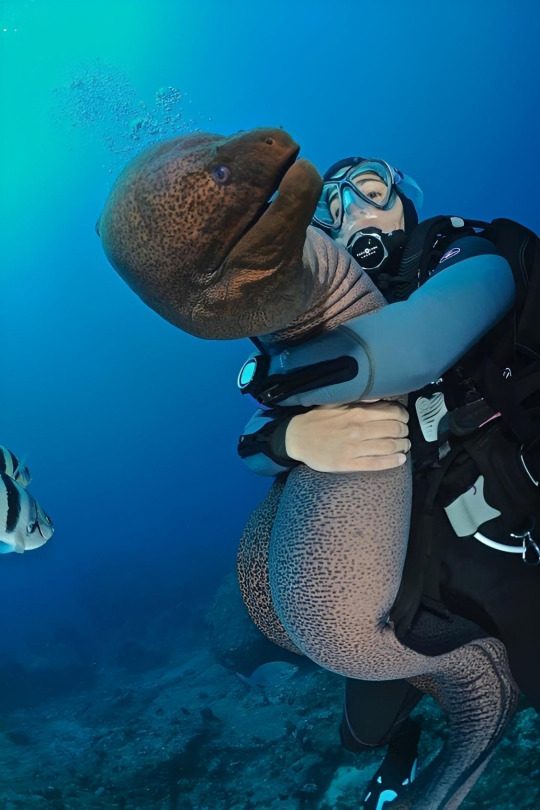
(Image: a SCUBA diver hugging a large, brown moray with black spots. End ID)
youtube
(Video: A shot video showing Valeria Taylor and a moray eel she befriended)
youtube
(Video: the song "That's a Moray", a parody of the song "That's Amore" by Dean Martin)
#wet beast wednesday#i accidentally typed moron eel more than once#moray eel#eel#anguiliformes#fish#bony fish#fishblr#fishposting#eelposting#marine biology#biology#ecology#zoology#animal facts#informative#image described#that's a moray#educational#Youtube
686 notes
·
View notes
Text

A new challenger approaches (slowly)
[First] Prev <–-> Next
#poorly drawn mdzs#mdzs#wei wuxian#wen chao#jin zixuan#jiang cheng#lan wangji#tulu xuanwu#Wen Chao's turtlephobia starts now. I wonder if that's ever going to come back into play?#Slight re-ordering of events for the funny punchlines but we're close to getting back on track.#The mianmian stuff happening right after we also have a Torment Tortoise looking for blood makes this scene so chaotic.#A good kind of chaos as it is supposed to be overwhelming and anxiety inducing!#I have been sitting on the idea of the Beast being just a normal turtle with a knife for ages. Years in fact.#It's stupid as hell but that's sometimes what art is. Indulging the past you who would have loved to see the dumb thing be drawn.#Making it canon now that A-Qing's turtle (the one pd-Lan Sizhui found) is a descendant of this turtle.#Maybe she was so defensive because she has eggs she was watching over! How insensitive of these cultivators!#You can insert your own choice of boss music here - I did not grow up playing video games so I have nothing off the top of my head.#I am making a BOTW reference here so you could substitute one of those themes but I find them more melancholic than menacing.
1K notes
·
View notes
Text
not to be that person but fuck
n don’t get me wrong I love smut as much as the next person but I cannot stand meaningless smut. With no substance just mindless sex with no passion or any ounce of affection attached to it. No buildup, no pining, no tension so thick it’s palpable no “fuck why are these jeans glued on” no “clumsiness or characters being awkward because sex is awkward sometimes and intimidating” no characterisation, character development or poking fun in a lighthearted way because
“dino boxers really?”
the way they’d be so unapologetic about it too maybe not even vocal but the look that fucking look that screams “yeah? n what you’re gonna do about it?” or maybe they’re flustered but that’s hot either way because it’s them, it’s their quirk
It’s the little details
The vulnerability? The insecurities—trying something new but being afraid to cross or plunge into unknown territories
but it’s their touch—guidance—that unspoken “you’re safe with me”
Subtle hotness/intimacy man
But yeah sex sells. Let’s be real. It’s a cheap way to get views especially when not mindful of how characters would react in such situations
#ellie williams x reader#ellie x reader#ellie williams imagine#tlou ellie#that girl smokes an expired old joint ONCE and y’all think she’s some kind of sex God😭#no but she would in fact wear dino boxers#I don’t think Ellie would engage in random hook up culture either bro she’s a LOSER LESBIAN#shes the queen of self deprecation needs encouragement or social cues before making the first move aka weed scene#only then does all HELL break lose#no but the way Dina pulled away for a split sec…mid making out bc she just ignited a beast
436 notes
·
View notes
Text
Talking to Lurien in a dream
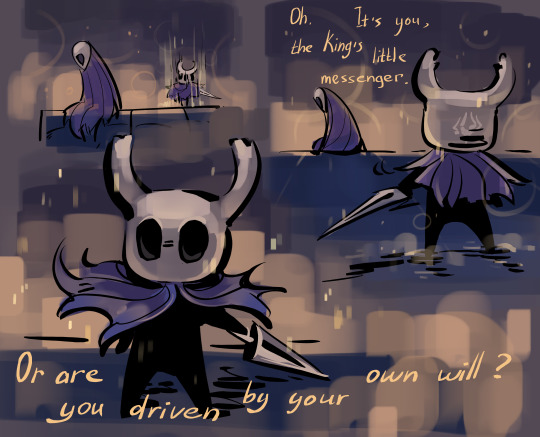

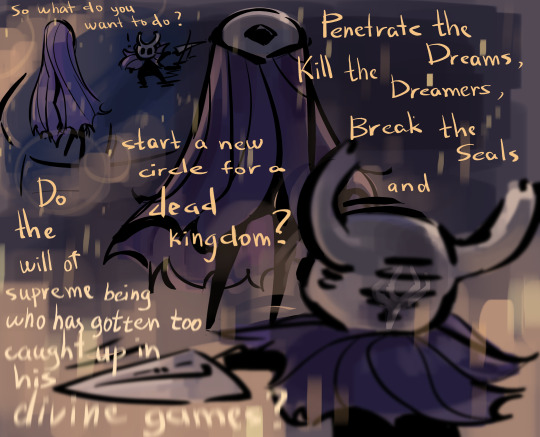


I'm sticking with the Godseeker ending, with a number of headcanons of my own
For example, that the Dreamers were aware of themselves and their surroundings the whole time they were in the Dreaming. And they could also keep an eye on the real world through the reveries of the not yet infected bugs
So, Herrah slipped into meditation, a dream within a dream, and didn't follow the real world, as she didn't see the point of it, since she couldn't affect it in any way anyway (Herrah didn't even follow her tribe or Hornet. She was used to controlling her life and always fighting for it, so when control was taken away from her, she simply withdrew into herself, for there was no point in aimless watching)
Monomon was mostly absorbed in Quirrell's dreams, following his wanderings, and her own musings on the nature of the mortal world and the dream world. The dreams of ordinary bugs didn't bother her much (Her biggest problem was her inability to write down her ideas. After a while, she even tried scratching out words on rocks, but that was hardly possible for non-existent objects. Especially if you only had soft tentacles)
Lurien, living up to his title of Watcher, had been watching the world through the bug's dream all this time (and since the King's plan went to hell, he's been subjected to the inevitable self-digging and self-loathing for giving his life away for free for a shitty plan by a shitty ruler) He's just too damn tired and frustrated, forgive him
And, after the ending of Godseeker, the Dreamers wake up from their slumber, and try to do something about the ruins of their kingdom. Working for free again ¦D
#I wanted to portray Lurien as less pathetic but he still looks pretty darn pathetic...#I'm sorry#In fact in my mind he's not so insignificant#He was an unassuming and withdrawn individual before becoming a Dreamer#But two decades spent isolated in the middle of nowhere while your King's plan cracks at the seams has awakened his resentment and anger#At least he realized he didn't want to live such a dismal life again if he could survive after all this of course#hollow knight#Hk#hk dreamers#hk little ghost#hk lurien#hk herrah#hk monomon#lurien the watcher#herrah the beast#monomon the teacher#hk the knight#hk ghost
405 notes
·
View notes
Text
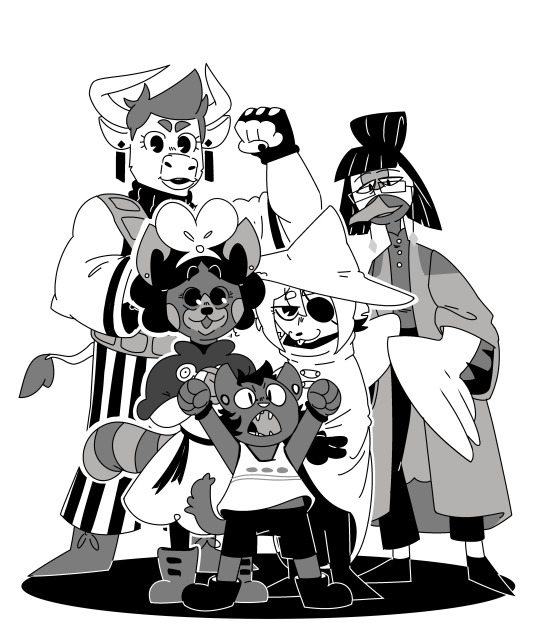
making the funky little guys funkier

the them
#i keep to my personal brand of everything can be made better by way of furrification#a bull a red panda a black kitty a crane and an ambiguously besnooted beast#three separate people called odile a Duck i dont know why is it something with the beak?#loop is a lion ;3#may or may not have candy#loop was supposed to be a quick funny sketch and then the background happened boo#had to take away bonbon's hat for the sake of composition#it adds like half a head of hight to them#ngl when i first saw isabeau i thought he was a cool butch lady and instead got a surprise nice buff man#the fact that he is not a himbo was shocking#also this game made me want to try a fish head what the hell#does the skull crunch?#in stars and time#furry art#furry#isat#siffrin isat#isabeau isat#mirabelle isat#odile isat#bonnie isat#loop isat#the whole gang is here#my art
417 notes
·
View notes
Text
they are such little creatures
#they are 5cm tall in my head#2 inch beasts#just little guys you know#hermitcraft#hc s10#hermitblr#hermitcraft demise#grian#falsesymmetry#bdoubleo100#xbcrafted#the fact that you can’t tag all hermits
337 notes
·
View notes
Text

sunbathing with the homies
(but GILLION'S OUT)(he's an eeper dude)(the eepiest fish in the sea)(and the beast is nowhere to be seen)(probably commiting atrocities)
#jrwi riptide#just roll with it#jrwi#jrwi fanart#jrwi chip#gillion tidestrider#jay ferin#albatrio#digital art#sketches#art inspired by the fact that it was so fucken hot today#wondering what the beast is up to#probably beating earl in chess#earl's eating her pieces when she's not looking#canon#UUUGH I FORGOT JAYS SCARS FOR FUCK'S SAKE
590 notes
·
View notes
Note
How are centaurs classified scientifically? They seem to technically be artiodactyls, but they'd have to be mammals and I can't tell if they're mammals or some other type of synapsid.
Those are all words describing taxonomic groups of animals that evolved on earth. Even though I sometimes compare aliens like centaurs to phylogenetic groups of earth animals, it's not a literal statement. When I say centaurs are mammal-like, what I mean is that they share some physiological traits we associate with mammals: endothermy, vivparity, feeding infant young with specialized glands, parental care, fuzzy, endoskeletal, vertebral spine. But they also have plenty of traits not associated with mammals: feather-like integument, unidirectional respiratory system, a central cognitive brain, a nervous cord the runs ventral to their vertebrae, lack of a post-anal tail, spinerettes, non-Terran biochemistry, etc, etc.
When talking about genuine taxonomical classes for aliens, you have to build an entirely new tree of life, from the bottom up. Centaurs do not even belong to the same domain of life as us. Physiological terms can be used to compare us to them, but like, they're not even eukaryotes.
#runaway to the stars#jaytext#speculative biology#fun fact is that this means centaurs are not technically ''animals'' in a taxonomic sense because they do not belong to the clade holozoa#They are beasts though. That one is not a science word :)
532 notes
·
View notes
Video
You can feel the power of a Bull Hippo just watching this, the most dangerous mammal in the world.

They aren’t fat at all, that’s all pure muscle! They cannot float, they just run along the bottom of the water!
#animals#nature#videos#scary#hippopotamus#hippos#animal facts#natural history#hippo#ungulate#mammal#animal#beasts#video#nature is metal#wildlife
3K notes
·
View notes
Text
In the Star Beast novelization it says that when the Doctor sees Donna again he just desperately wants to give her a giant hug and that it burns him that he can’t. If you even care.
#doctor who#fourteenth doctor#donna noble#the star beast#doctor who 60th anniversary#yes I KNOW most of you already know this#this keeps me up at night#imagine seeing your best friend in the universe#for the first time in 15? 1000? 4 billion? an unknowable number of years#the person you missed so much you built your entire current identity around that missing#and you can’t give them a hug#I can’t even GET to the rest I can’t even GET to the fact he has to act like he’s got no idea who she is#I can’t even GET to him having to hear her not know him#the fact that he can’t give her a hug does too much psychic damage
255 notes
·
View notes
Text


You cannot save people, you can only love them.
Language of flowers and Alternate Universe (Day 2 and 5)
{I chose yellow chrysanthemums because it symbolises strong bonds, and also neglected love ^^✨}
#bsd#bsd fanart#bungo gay dogs#beast skk#skk#bsd chuuya#bsd dazai#bsd beast#beast dazai#beast chuuya#my favourite divorced couple#look at them#Beast will always shred my heart into decimals not even fractions bro istg#chuuyaweek24#chuuyaweek2024#my art#sad onion noises#asagiri when i catch you asagiri#the fact that this sentence can tie to the both of them but the feelings aren't reciprocated to chuuya is breaking something in me
152 notes
·
View notes
Text
I recently found out a show I liked is 10 years old now so to not be the oldest thing on this blog I'm talking coelacanths for Wet Beast Wednesday. Coelacanths are rare fish famed for being living fossils. While that term is highly misleading, it is true that coelacanths are among the only remaining lobe-fined fish and were thought to have gone extinct millions of years ago before being rediscovered in modern times.
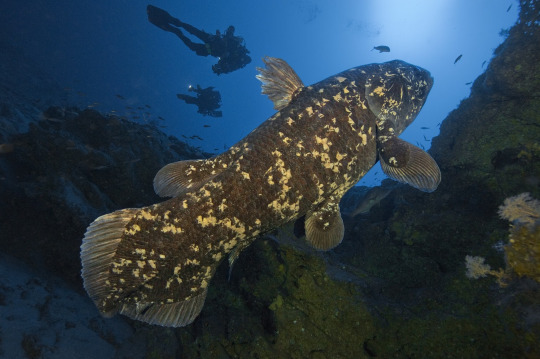
(image id: a wild coelacanth. It is a large, mostly grey fish with splotches of yellowish scales. Its fins are attached to fleshy lobes. It is seen from the side, facing the top right corner of the picture)
Coelacanth fossils had been known since the 1800s and they were believed to have gone extinct in the late Cretaceous period. That was until December 1938, when a museum curator named Marjorie Courtenay-Latimer was informed of an unusual specimen that had been pulled in by local fishermen. After being unable to identify the fish, she contacted a friend, ichthyologist J. L. B. Smith, who told her to preserve the specimen until he could examine it. Upon examining it early next year, he realized it was indeed a coelacanth, confirming that they had survived, undetected, for 66 million years. Note that fishermen living in coelacanth territory were already aware of the fish before they were formally described by science. Coelacanths are among the most famous examples of a lazarus taxon. This term, in the context of ecology and conservation, means a species or population that is believed to have gone extinct but is later discovered to still be alive. While coelacanths are among the oldest living lazarus taxa, they aren't the oldest. They are beaten out by a genus of fly (100 million years old) and a type of mollusk (over 300 million years old).

(image: a coelacanth fossil. It is a dark brown imprint of a coelacanth on white rock. Its skeleton is visible in the imprint)
Coelacanths are one of only two surviving groups of lobe-finned fish along with the lungfishes. Lobe-finned fish are bony fish notable for their fins being attached to muscular lobes. By contrast, ray-finned fish (AKA pretty much every fish you've ever heard of that isn't a shark) have their fins attached directly to the body. That may not sound like a big difference, but it actually is. The lobes of lobe-finned fish eventually evolved into the first vertebrate limbs. That makes lobe-finned fish the ancestors of all reptiles, amphibians, and mammals, including you. In fact, you are more closely related to a coelacanth than a coelacanth is to a tuna. Coelacanths were thought to be the closest living link to tetrapods, but genetic testing has shown that lungfish are actually closer to the ancestor of tetrapods.
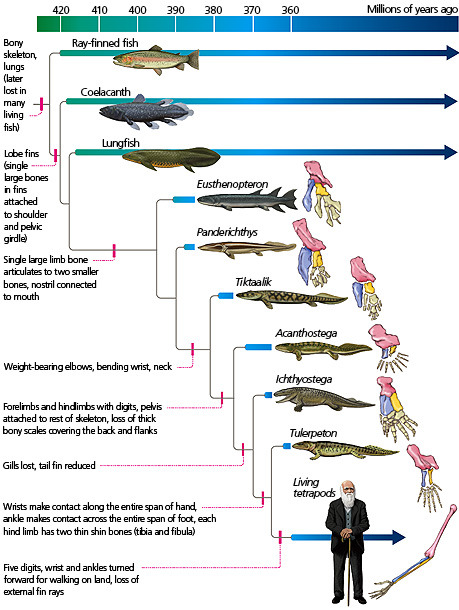
(image id: a scientific diagram depicting the taxonomic relationships of early lobe-finned fish showing their evolution to proto-tetrapods like Tiktaalik and Ichthyostega, to true tetrapods. Source)
There are two known living coelacanth species: the west Indian ocean coelacanth (Latimeria chalumnae) and the Indonesian coelacanth (L. menadoensis). Both are very large fish, capable of exceeding 2 m (6.6 ft) in length and 90 kg (200 lbs). Their wikipedia page describes them as "plump", which seems a little judgmental to me. Their tails are unique, consisting of two lobes above and below the end of the tail, which has its own fin. Their scales are very hard and thick, acting like armor. The mouth is small, but a hinge in its skull, not found in any other animal, allows the mouth to open extremely wide for its size. In addition, they lack a maxilla (upper jawbone), instead using specialized tissue in its place. They lack backbones, instead having an oil-filled notochord that serve the same function. The presence of a notochord is the key characteristic of being a chordate, but most vertebrates only have one in embryo, after which it is replaced by a backbone. Instead of a swim bladder, coelacanths have a vestigial lung filled with fatty tissue that serves the same purpose. In addition to the lung, another fatty organ also helps control buoyancy. The fatty organ is large enough that it forced the kidneys to move backwards and fuse into one organ. Coelacanths have tiny brains. Only about 15% of the skull cavity is filled by the brain, the rest is filled with fat.

(image id: a coalacanth. It is similar to the one on the above image, but this one is blue in color and the head is seen more clearly, showing an open mouth and large eye)
One of the reasons it took so long for coelacanths to be rediscovered is their habitat. They prefer to live in deeper waters in the twilight zone, between 150 and 250 meters deep. They are also nocturnal and spend the day either in underwater caves or swimming down into deeper water. They typically stay in deeper water or caves during the day as colder water keeps their metabolism low and conserves energy. While they do not appear to be social animals, coelacanths are tolerant of each other's presence and the caves they stay in may be packed to the brim during the day. Coelacanths are all about conserving energy even when looking for food. They are drift feeders, moving slowly with the currents and eating whatever they come across. Their diet primarily consists of fish and squid. Not much is known about how they catch their prey, but they are capable of rapid bursts of speed that may be used to catch prey and is definitely used to escape predators. They are believed to be capable of electroreception, which is likely used to locate prey and avoid obstacles. Coelacanths swim differently than other fish. They use their lobe fins like limbs to stabilize their movements as they drift. This means that while coelacanths are slow, they are very maneuverable. Some have even been seen swimming upside-down or with their heads pointed down.
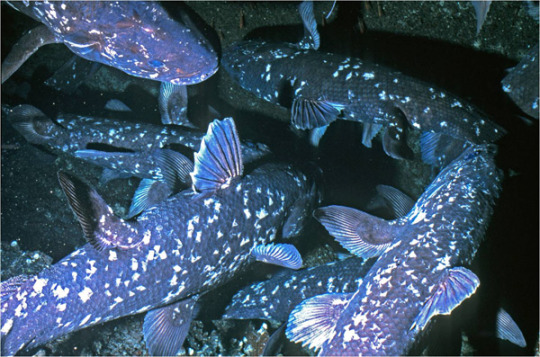
(image: an underwater cave wilt multiple coelacanths residing in it. 5 are clearly visible, with the fins of others showing from offscreen)
Coelacanths are a vary race example of bony fish that give live birth. They are ovoviviparous, meaning the egg is retained and hatches inside the mother. Gestation can take between 2 and 5 years (estimates differ) and multiple offspring are born at a time. It is possible that females may only mate with a single male at a time, though this is not confirmed. Coelacanths can live over 100 years and do not reach full maturity until age 55. This very slow reproduction and maturation rate likely contributes to the rarity of the fish.

(image: a juvenile coelacanth. Its body shape is the same as those of adults, but with proportionately larger fins. There are green laser beams shining on it. These are used by submersibles to calculate the size of animals and objects)
Coelacanths are often described as living fossils. This term refers to species that are still similar to their ancient ancestors. The term is losing favor amongst biologists due to how misleading it can be. The term os often understood to mean that modern species are exactly the same as ancient ones. This is not the case. Living coelacanth are now known to be different than those who existed during the Cretaceous, let alone the older fossil species. Living fossils often live in very stable environments that result in low selective pressure, but they are still evolving, just slower.
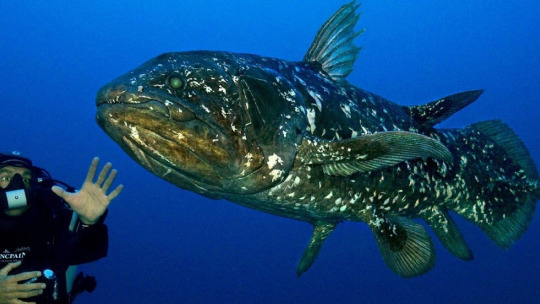
(image: a coelacanth swimming next to a SCUBA diver)
Because of the rarity of coelacanths, it's hard to figure out what conservation needs they have. The IUCN currently classifies the west Indian ocean coelacanth as critically endangered (with an estimated population of less than 500) and the Indonesian coelacanth as vulnerable. Their main threat is bycatch, when they are caught in nets intended for other species. They aren't fished commercially as their meat is very unappetizing, but getting caught in nets is still very dangerous and their slow reproduction and maturation means that it is long and difficult to replace population losses. There is an international organization, the Coelacanth Conservation Council, dedicated to coelacanth conservation and preservation.
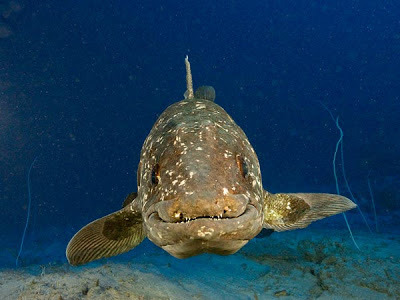
(image: a coelacanth facing the camera. The shape of its mouth makes it look as though it is smiling)
#wet beast wednesday#coelacanth#marine biology#biology#zoology#ecology#animal facts#fish#fishblr#old man fish#lobe-finned fish#sarcopterygii
1K notes
·
View notes
Text
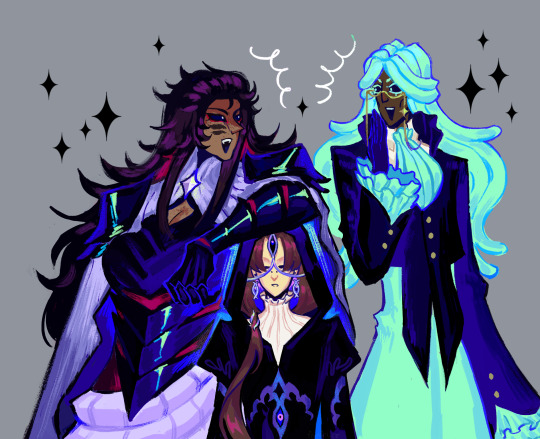
the ✨️girlies✨️ and lurien
#fanart#hollow knight#hollow knight fanart#hk#monomon the teacher#hk monomon#lurien the watcher#hk lurien#herrah the beast#hk herrah#hollow knight gijinka#i think im going to redesign them at least a hundred more times#FUN FACT lurien has no eyebrows#where'd they go tho
367 notes
·
View notes